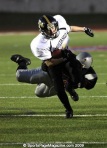This week I read two separate stories about female collegiate coaches who are no longer coaching due to homophobia. Scholars have been writing about the effects of homophobia on women’s sports for decades, yet it persists.
The first story is about University of Minnesota Associate Women’s Golf Coach Katie Brenny. All the facts are not in yet, but allegedly Brenny was relieved of many of her coaching duties when the Director of Golf, John Harris, learned that Brenny was a lesbian. You can read about this story in the MN Daily, here and here. It was announced this week that Brenny plans on suing the University of Minnesota for “a violation of several Minnesota statutes, which would include discrimination based upon creating a hostile work environment; discrimination, retaliation and harassment; and discrimination concerning sexual preference.” Note: 12/10/10 Star Tribune story on Brenny.
The second story involves Lisa Howe, Belmont University’s Head Women’s Soccer Coach, “who resigned last week after she told school officials that she and her same-sex partner were expecting a child.” Howe felt she should resign in the “don’t ask, don’t tell,” climate at Belmont rather than be fired “due to her poor choices.” To read more about this story click here and here and Pat Griffin has also written a number of blogs about Howe.
There are many troubling issues about these two stories, but in light of my research on the scarcity of female coaches, I find them particularly interesting. Females coaches are in the minority at all levels—youth, high school and college (if you want to see the statistics, click on these links). The barriers and factors which influence this phenomenon are complex, but in these cases, I think it is safe to say homophobia and a climate of intolerance are contributing factors as to why we now have 2 fewer female college coaches.
Austin Calhoun, a graduate student, and I completed research on how gay and lesbian coaches are erased from online sport media. When we heard of Howe and Brenny, we looked at their online coaching biographies and were not shocked to learn neither mentioned their same-sex partners.
While Brenny seemed to be released from her duties because she was gay, Howe quit because she couldn’t stay in the closet (and resumably didn’t want to) once she and her same-sex partner were going to have a baby. Interestingly, having children dramatically affects both heterosexual and homosexual female coaches, in some similar, but also in some very different ways.
For gay women, having a child makes it harder to stay in the closet, and once you have a child with someone you love, one presumably would prefer to openly and freely share that love and joy with the world–including one’s team and colleagues. However, gay coaches are then faced with a dilemma: Come out and risk their career, or stay in the closet and alienate and erase their newly expanded family. Young gay female coaches in the early stages of their careers and families, may have very different thoughts and values about being openly gay in the workplace than their older generational counterparts. Therefore, it is likely that the attrition rate of young gay female coaches may increase as they want to live openly, but bump up against institutional and societal homophobia. This group of young women may also choose not to enter the coaching profession to begin with (stay tuned for cutting edge research on this topic and more from my graduate student Alyssa Norris).
For heterosexual women, having a child makes it harder to balance the work-mother roles unless a supportive male partner is willing to take on some of the domestic labor in the home (I realize that same-sex couples have to also balance domestic labor issues). For this group of women, having a child does not directly threaten your job. In fact, it is celebrated (as it should be!). Researchers have documented that despite gains made by women in the workplace, women are still responsible for a majority of the domestic labor in the home. For many women (gay and straight alike), balancing the coach-mother roles proves to be too stressful and often results in quitting the coaching profession. What may compound this issue for females coaches with male partners is that a gender pay gap still exists where females make on average .77 cents for every dollar a male earns. Thus, if a heterosexual couple is deciding who is going to stay home (if that is even an option) or how to lessen the workload, it often makes better financial sense for the male to remain in his career/job.
Of note, when a male coach and his female partner have a child it rarely affects the male coach’s career trajectory or job security. One key take home: in order to have a successful coaching career, a female must have a supportive and equal partner. Another key take home is that gay female coaches likely face more barriers than their heterosexual counterparts which makes staying or getting into coaching challenging.
I have more thinking to do about this complex issue, but these two stories illustrate a few key contributing factors in the ongoing scarcity of female coaches. I realize my logic on this is not fully developed, and I would love to hear your constructive thoughts.
Addition 12/10/10: A NYT piece about a wife-husband co-head coaching duo for Mizzou Volleyball is an example of how heterosexual coaches can be visible and celebrated, whereas I doubt you would ever see a similar story on same-sex co-head coaches. This story is also an example of how if a mother-coach is going to succeed she needs a supportive and equal partner.
Addition 12/17/10: A NYT piece on Howe and the reaction of her athletes and the community.













